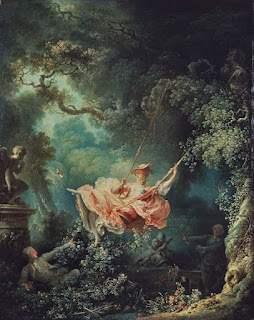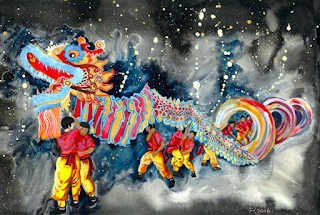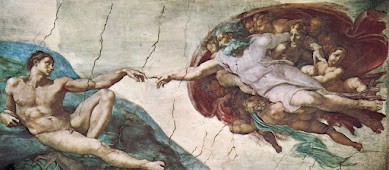Classical Blog
Classical Blog
Painting Description
The oil painting shown above was created by Jean-Honore Fragonard during the 18th century between 1767 and 1768 in the Wallace Collection in London. The painting is often referred to as "The Happy Accidents of The Swing".
Connection
These paintings of the classical era were often seen as playful and light as often following the template of Rococo style artwork. During this time frame, the morals of an art piece weren't what drove the painters and viewers but rather the visual pleasure which the piece gave off was the goal. These paintings were meant to inspire individuals to have good morals and were not pushing the boundaries of what society found acceptable. Many people of this time especially the middle class found these works to be a moral decline for the middle class.
Analysis
In this oil painting, we can see the obvious of a woman on a swing while surrounded by nature and surrounded by shades of dark greens. When taking a closer look at the photo, you can see a man in the background pushing the lady and also the man hiding in front taking a peak up the ladies dress. This painting can be taken a number of ways but to me, I think of a secret love affair between the hiding man and the woman on the swing. During this time there was a major separation between classes and it was often looked down upon to be with someone who was outside of your status.
The details of the lady's full pink dress flowing in the wind represent the beauty that comes with money while also sitting on a gold swing. The detail of the edging on the women's dress and the energy the dress gives off is part of the rapid brushwork that was used by the artist. The bright dress which the lady is wearing stands out in front of the darker background behind her making the woman the obvious center of attention. Personally, this art piece is not my favorite because it doesn't appeal to my taste in modern art.
Painting Description
This painting by Jacques-Louis David was created in 1787 in France. The piece is often referred to as "The Death of Socrates".
Connection
This piece shows how the accident greeks were used to show virtue. In this timeframe, the ancient government was not a fan of Socrates' teaching and they were forced to choose between exile and death. This piece above it shows how prideful a Socratetryuly truly is as he chooses death over giving up his beliefs and morals. This shows moral injustice as only a certain group of people were able to express their beliefs and religions to others.
Analysis
In this painting, I see beauty in strength showcased by the man in the front sacrificing himself for what he believes is something greater than himself. The facial features that each man in the painting give off show many emotions such as anger, frustration, sadness, and guilt. To me, I feel a sense of guilt knowing that the man making the sacrifice is being wrongfully convicted for having his own beliefs. The setting of stone all around the characters and the outfits of cloth which they are all wearing give for a very old fashioned era. The colors used in this painting also show who the person being poisoned is since he is the only one wearing a red outfit which is the color of blood and can often be associated with death. Personally, this is my least favorite of the three paintings I chose since it makes me feel uneasy due to the dark setting and the forseeing of death.
Painting Description
This painting was created by swiss-born painter Angelica Kauffmann in 1785. The painting was created in Circa. This piece is known as "Cornelia, Mother of Gracchi, Pointing to Her Children as Treasures".
Connection
The connection to morals which this piece portrays is how the mother Cornelia is asked about her treasures by the lady in the red dress and responds with her children as being her treasures. In a time where materialistic items were valued as such high treasures, Cornelia responding with her ids as her true treasures shows the strong morals and how she goes against the norms at this time. This shows the great love and connection that a mother has for her children.
Analysis
In this painting, we see a beautiful image of the mother in white taking care of her three children while being accompanied by the lady in the red dress. The lady in the red dress is presenting the mother with all of her materialistic goods such as jewelry and other goods but what makes this painting special is how the mother is shown to be ignoring these materialistic goods and rather demonstrating that her true treasures are her kids. This is a beautiful image of how strong a mother's love is for her children and the values which are greater than any object. The white dress in the painting is a sign of purity and grace. The detail shown in each of the characters outfits is very impressive and worth noting as each crease and line can be captured by the painting. I would own a piece such as this since I believe that family is everything and this painting is a representation of my morals.
Sources:
Chanda. “Art, Music, and Morality in the Classical Era.” a Work in Progress, 8 Mar. 2013, https://fbxchanda.wordpress.com/2013/03/05/art-music-and-morality-in-the-classical-era/.
“Fragonard, the Swing (Article) | Rococo.” Khan Academy, Khan Academy, https://www.khanacademy.org/humanities/renaissance-reformation/rococo-neoclassicism/rococo/a/fragonard-the-swing.






Hi Garrett,
ReplyDeleteGreat work picking these art pieces, I think all of them are fitting for the assignment! I like the layout of your post, as it makes the works easier to appreciate by giving them all of the attention ! I would actually like to own the 1st art piece, since it is popular and looks like it adds energy to the place it would be displayed!
Overall a great job on the blog post!
I like how your blog is broken down into the painting description, connection, and analysis sections. I never thought about doing that. The connection you made to the classical era and “The Happy Accident of the Swing” is good. There are a lot of hidden details in this painting that you did a good job pointing out. I think you are correct in your assessment of a secret love affair.
ReplyDeleteI do think that “The Death of Socrates” shows strength because he chooses death over given up his beliefs and morals. It is a very emotional painting. I think I would agree with you in that this is my least favorite of the three paintings you picked.
Wow, I think your connection and analysis of “Cornelia, Mother of Gracchi, Pointing to Her Children as Treasures” is great. I like how you point out that in a time where materialistic items are important, she chose her kids as her treasures. I think in this day in age that remains with us, in most cases. A mother’s love is very strong and if all you have all are materialistic things, you cannot know that kind of love. I like how you point out her white dress. It’s not something I even noticed or picked up on.
Hello Garrett,
ReplyDeleteI like the "The Happy Accidents of The Swing" painting that you posted. I had never seen it before but when looking at it I can notice the Rococo style. I think that it is the color contrast that makes this painting so attractive. The pink dress and the shades of dark green makes want to own a copy of the painting myself.
In my opinion, "The Death of Socrates" has a lot of meaning behind it as you described. By looking at all the artwork the characteristics of classical era display which means that you did a great job by choosing the paintings. You also did a great job describing the mothers connection to their kids and the strong morals showed in "Cornelia, Mother of Gracchi, Pointing to Her Children as Treasures"
In my opinion, you were spot on with the descriptions of all paintings for this post. Great job!
I enjoyed your description of the art elements in the paintings and the story behind the art, and how you interpreted them. The first painting can have many backstories of how a person sees the story of the painting. The one you described, I can see that to be it. I enjoy the Rocco style art because it is visually pleasing. The second painting of "The Death of Socrates." is one of my favorites because I believe the art representing moral injustice is essential. It is a visual of something in society that needs to change. I enjoyed your description! I enjoyed your entire blog post, an excellent job!
ReplyDelete